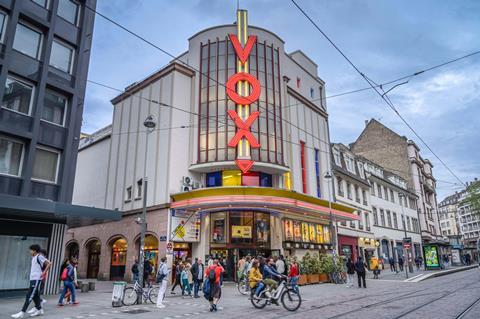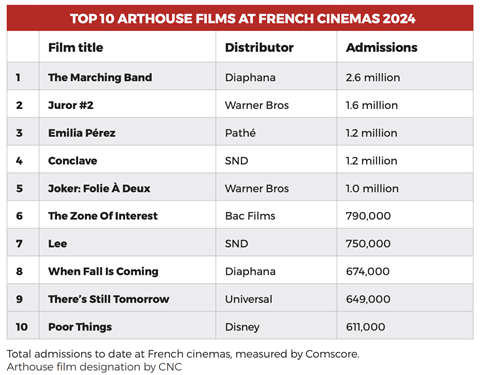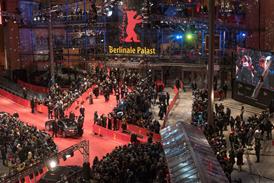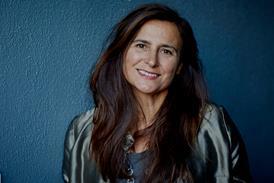
France has long been considered an ideal market for independent and foreign-language films, and famously considers cinema its “seventh art form”.
The French exhibition market for arthouse cinema from home and around the world continues to thrive thanks to a combination of pan-European and state-sponsored aid and initiatives from French distributors and exhibitors to woo audiences throughout the year, all in a country famous for its ‘exception culturelle’ (cultural exception) where cinema is valued as an art, and not just a commercial vehicle.
In 2024, arthouse films represented a total of 45.3 million admissions in French cinemas, 25% of the year’s total tally of 181.3 million. That amounts to €326m ($353m) of the €1.3bn ($1.4bn) French box office based on an average ticket price of €7.20 ($7.80).
“The synergy between movie theatres, industry professionals and audiences has created France’s unique and vibrant market for arthouse cinema,” suggests Marc-Olivier Sebbag, executive director of the National Federation of French Cinemas (FNCF).
Arthouse market
The vibrant market for arthouse films starts with first designating films as such. Films and cinemas in France are given a specific ‘art et essai’ label based on a classification system from state film organisation CNC. A cinema’s designation as an arthouse theatre is decided by CNC based on the recommendation of several regional committees. A film’s classification as arthouse is a process determined by CNC, which delegates the mission to AFCAE, France’s organisation of arthouse cinemas. Cinemas can apply for classification, but all films released in France must first pass through the recommendation committee.
A film’s budget and distributor are not taken into account when deter- mining the arthouse label, and films in competition at category-A festivals are almost always recommended as arthouse — including, for example, Warner Bros’ Venice 2024 competitor Joker: Folie À Deux.
AFCAE, which has 1,200 arthouse cinemas among its members, deploys a series of initiatives to support arthouse films in their theatrical release including monthly recommendations for classified arthouse titles, festivals and events throughout the year, and the ‘Prix des Cinémas Art et Essai’ in partnership with Cannes to provide support for a film in official competition (last year it went to Mohammad Rasoulof’s The Seed Of The Sacred Fig). One of the organisation’s key initiatives is the 15-25 Committee, which is tasked with selecting and recommending films specifically aimed at the younger demographic, with programming tips for local exhibitors and regular studies on audience behaviour.
Last year, CNC increased its annual budget for arthouse cinema support by €1m ($1.08m) to €19m ($20.6m) — a fund that rewards exhibitors programming a certain proportion of arthouse films, and supports marketing efforts. It also revamped its system for calculating the amount of funding that theatres receive, with more money being earmarked for cinemas screening what CNC describes as “risky” programming, namely more experimental, lower-budget films.

In France, watching films with subtitles is part of the culture, built from an early age. Initiatives begin with state funding for educational drives from the Ministry of Culture and CNC known as ‘l’education à l’image’ to foster an affinity for moviegoing, running from elementary school through university level.
“The work of distributors and cinemas has been built up for the past 20 or 30 years, and audiences have evolved with it,” explains Sebbag. “It is a national arthouse policy that is constructed with long-term ambitions — it hasn’t been an overnight sensation.”
In addition to French funding and programmes, European arthouse films are supported by Creative Europe Media — which supports the circulation of content from the continent through distribution aid in addition to funding for sales agents, exhibitors, markets and festivals.
Media’s 2024 budget was around €186m ($201m), of which €63m ($68m) was used to support distributors in acquiring and promoting non-national European works and €30m ($32m) for exhibitor support to feature European titles in programming.
“The selective support from Media has been key for us in helping our European independent films to exist,” says Marie Foulon, head of acquisitions at Paname Distribution, which releases six to eight arthouse titles per year including early 2025 hit Jane Austen Wrecked My Life (117,000 admissions at press time). “Our company — like arthouse cinema in France — can only exist if it’s constantly defended and supported.”
France’s media chronology, which regulates how long films must wait before heading to other distribution channels (see feature, overleaf), has bolstered the performance of arthouse titles by giving them a healthy window to flourish in cinemas — a minimum of four months before they’re able to roll out on VoD, streamers and broadcasters. In other markets, theatrical windows for arthouse titles may be truncated.
Local boost
Film ‘labels’ among major local distributors are also increasingly important for boosting both exhibitor and audience awareness of otherwise often-overlooked titles. These include Pathé’s ‘coup de coeur’ standout titles or ‘l’autre regard’ for recommended arthouse films, mk2 Films’ ‘we saw it, we liked it’ label or UGC’s staff picks and arthouse discovery titles. In addition to education initiatives, CNC funding and a boost from distributors, local mayoral districts also work to push moviegoing in their districts.
French arthouse cinemas accounted for a 36.9% national market share or 66.9 million admissions (€481m/$521m) in 2024. While down 10.1% from an exceptional 2023, total box office for arthouse films by market share was still up 21.7% from 2022 and 22.8% better than the pre-pandemic 2015-19 average. Local productions accounted for 35% of the year’s arthouse admissions, and UK titles earned a 31% market share.
Emmanuel Courcol’s The Marching Band was the top arthouse title of 2024, and is still going strong in cinemas with some 2.6 million admissions to date. The top 10 chart (see below) includes a mix of titles from a range of countries, including awards season successes The Zone Of Interest, Conclave and Poor Things, Francois Ozon’s When Fall Is Coming and Paola Cortellesi’s Italian drama There’s Still Tomorrow.

“Since the pandemic, arthouse cinemas have suffered in France, but less so than other territories,” says David Obadia, who runs AFCAE. “Everyone announced the death of the movie theatre during the pandemic, in particular for arthouse cinemas, but in France we have been lucky and it’s proof that our unique model works.”
International arthouse titles consistently do better in France than other markets. Andrea Arnold’s Bird, for example, which premiered in Cannes Competition, has sold some 115,000 tickets since its January 1 release via Ad Vitam for an estimated €832,000 ($900,000), far above its £266,000 ($343,000) in UK and Ireland cinemas.
“Bird worked better in France than in the UK,” says Grégory Gajos, Ad Vitam’s director of sales and acquisitions. “Arnold is well-known in France, the film had good reviews out of Cannes and it was widely programmed in cinemas. In France, there is a real respect and recognition of filmmakers, and audiences follow them.”

Ad Vitam released Delphine and Muriel Coulin’s Venice best actor prize winner The Quiet Son, which has shifted 465,000 tickets (€3.3m/$3.6m) since its January 22 release. The Seed Of The Sacred Fig has made some €4.4m ($4.8m) in France — a notable outcome for a three-hour politically charged Iranian drama. In comparison, box office had reached £275,000 ($357,000) in the UK and Ireland after six weeks. In Germany, which chose The Seed Of The Sacred Fig as its submission for the international feature Oscar, box office totalled €1.98m ($2.16m).
Films that premiere in Cannes tend to land well with French audiences: Palme d’Or winner Anora sold some 629,000 tickets during its autumn 2024 run (€4.5m/$4.9m), significantly ahead of the UK’s £2.8m ($3.6m) tally. Further Cannes successes at French cinemas include The Apprentice (272,000 admissions), Souleymane’s Story (607,000 admissions), Misericordia (229,000 admissions), The Substance (584,000 admissions), The Most Precious Of Cargoes (611,000 admissions) and Louise Courvoisier’s Holy Cow (931,000 admissions). Several of those films are still going strong in cinemas in 2025, particularly after winning top prizes at France’s César Awards and the Oscars.
Pyramide Distribution, which released Holy Cow, The Seed Of The Sacred Fig and Souleymane’s Story, enjoyed a strong 2024. Pascal Bonitzer’s Auction (370,000 admissions), Arnaud and Jean-Marie Larrieu’s Jim’s Story (403,000 admissions), Thierry de Peretti’s In His Own Image (121,000) and Emmanuel Mouret’s Venice premiere Three Friends (281,000) also performed well for the independent distributor.
Audiences for arthouse films have extended to different genres including animation such as 2024 release Kensuke’s Kingdom, which sold 450,000 tickets in France (€3.2m/$3.5m), far above the UK and Ireland’s tally of £194,000 ($250,000) — despite being based on a book by British author Michael Morpurgo and lead-produced by the UK’s Lupus Films. Dialogue-free Oscar winner Flow (UFO) has sold 682,000 tickets (€4.9m/$5.4m) in France, while fellow nominee Memoir Of A Snail sold 103,000 tickets (€742,000/$810,000), compared to £160,000 ($208,000) in the UK and Ireland. (Flow was released in the UK and Ireland on March 21, after this issue went to press.)
While France’s $1.4bn total box office in 2024 represented 4.7% of the year’s global total, the country’s share for many independent films is much higher: France has thus far delivered 19% of Flow’s box office, for example.
Fine tuning
Despite a mostly thriving sector, Obadia points out: “A major challenge has been that certain arthouse films overperform while other smaller, more fragile titles are finding it harder to exist”, and that AFCAE is working to even out the playing field by supporting such titles.

Sarah Chazelle, co-founder of Jour2Fête, flags that “programmers increasingly concentrate on a few films per week, and those that aren’t highlighted are often forgotten”. The distributor’s César-winning French farming documentary La Ferme Des Bertrand has sold some 245,000 tickets (€1.8m/$1.9m) and Sophie Fillieres’ Cannes Directors’ Fortnight premiere This Life Of Mine a solid 146,000 (€1m/$1.08m), while critically acclaimed festival and award-winning titles such as Orlando, My Political Biography (7,600 admissions), Tiger Stripes (4,200 admissions) and Julie Keeps Quiet (13,000 admissions) have struggled to woo French filmgoers.
“[There is a] polarisation of the market,” says Tandem Films founder Mathieu Robinet. “If exhibitors do not select a film as their favourite in a given week, it can easily be forgotten since there’s such a quick turnover.” Antoine Chevrollier’s debut feature Block Pass has been a solid 2025 release for Tandem with 185,000 admissions after five weeks in cinemas, while other titles failed to garner enthusiasm even after bowing in the Cannes line-up.
The polarity also extends geographically. Arthouse films thrive more easily in bigger cities, but the gap is being addressed. “Rural areas are working hard to maintain a high quality of arthouse programming, and we can see that this work is paying off,” says Obadia. France’s culture minister Rachida Dati is spearheading state efforts to boost cinemagoing in such areas.

Last year, France’s Urban and Rezo Films both shuttered their distribution arms, with Urban founder Frédéric Corvez citing a “disturbing industry trend” in which non-arthouse local cinemas strongly favour blockbuster releases over independent titles.
Unique in France is what Sebbag describes as “a tradition to offer many films, not just ones that work”. Unlike territories such as the US or UK, he explains, “Movie theatres don’t just programme what they know people want to see — they propose a diversity of films to attract all different types of audiences. They show Hollywood blockbusters, but also documentaries or heritage films — always something for all audiences of all ages and demographics so they want to continue going to the movies. They’re in it for the long game.”
Paname’s Foulon agrees. “We buy films because we love films,” she says. “Our editorial policy is simply having a heartfelt connection to a film and wanting to share it with audiences.”
Ad Vitam’s Gajos credits the success of arthouse titles to the work done all year by local exhibitors to keep audiences engaged. “We have a strong system of arthouse exhibitors in France. It is very developed both in terms of quality of programming and in terms of constantly working to loyalise audiences and keep them coming back throughout the year.”
Supporting the arthouse industry is a labour of love for most French distributors and exhibitors. “To release a movie in a cinema — even for our smaller titles that end up on limited 40-50 screens — the minimum cost is some €120,000 [$130,000] between the release, marketing and reeling in audiences,” says Foulon. “Distributors and exhibitors in France are often very passionate people who love cinema and take a lot of risks.”
























1 Readers' comment